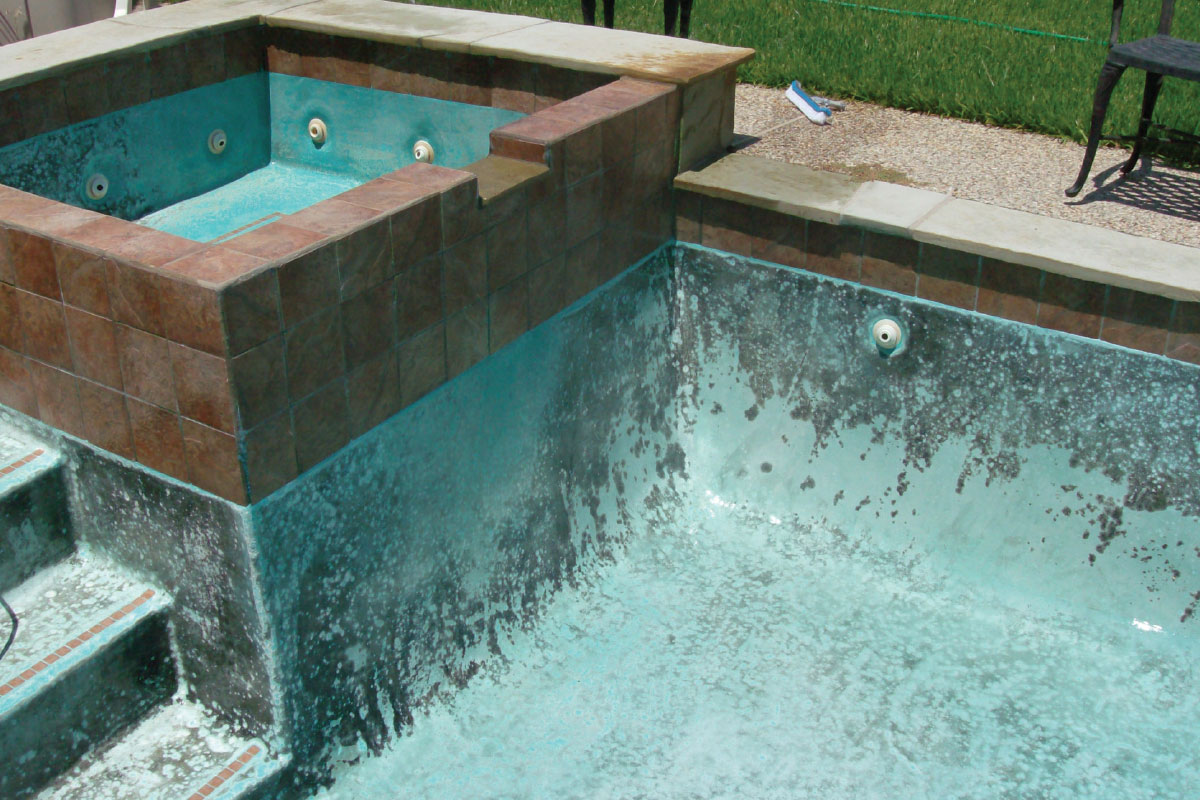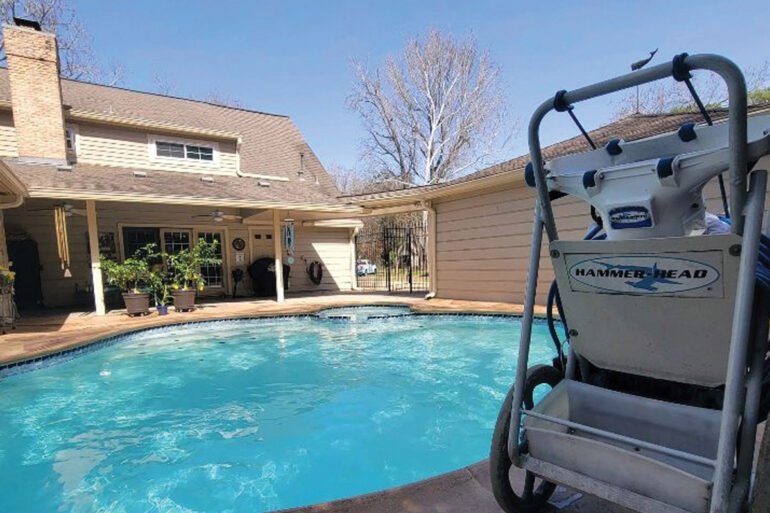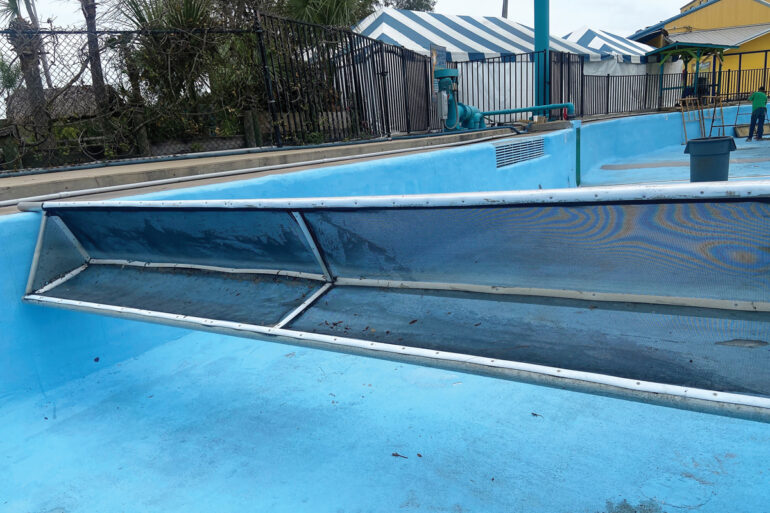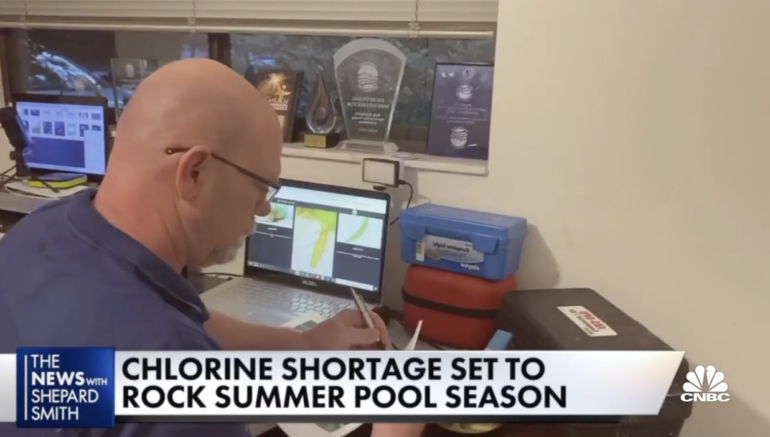The Chemistry of Copper

We know that iron stains are easily removed by vitamin C because ascorbic acid is a natural electron donor. It replaces electrons stripped from iron in oxidation, taking us from ferric oxide to ferrous oxide, which is soluble, lifting the stain. However, despite its success with iron, ascorbic acid doesn’t work very well for the many colors of copper’s blemishes.
You likely already know how copper gets in the water, but humor me. The most common reason is a homeowner overdosing copper algaecide, some wackadoo tossing tabs in the skimmer, a dip in pH quickly corroding a heat exchanger or other bronze components (bronze is 88% copper). Fill water could do it, so your city water quality report can alert you of what to look for.
Getting from a high copper level to copper stain can happen in a few different ways. This list isn’t all-inclusive, but none the less, the principle will remain constant: Staining occurs when soluble copper ions bond with something else in the water and become insoluble.
Ever turn a pool cloudy blue? Adding a chemical can result in an immediate reaction if a copper level is present, which is rarely aesthetically pleasing; it can be downright alarming. Depending on how it’s added, a dose of soda ash (sodium carbonate) to raise the pH can easily result in copper carbonate turning the pool water a chalky capri color. This happens when the metal forms a compound with the chemical’s carbonate, and it starts to precipitate. Luckily, copper carbonate tends to stay in solution long enough to be removed through filtration.
Teal Staining
A cup of caustic soda to raise the pool water’s pH can quickly leave a green-blue stain when it reacts with the water’s copper. Caustic soda is also known as sodium hydroxide or lye, and is not as uncommon a pH adjuster as you might think.
There are many products already available in the market that work well for removing this type of stain. The ingredients are typically hydrogen peroxide, sulfuric acid or citric acid. Citric acid-based products will often succeed where ascorbic acid has failed. Oxalic acid-based products will also work well; however, they can cause an undesirable ‘dusting’ on the pool floor.
I wouldn’t go dumping muriatic acid (HCl) into a swimming pool that has a high level of copper, either. The chlorides (the ‘Cl-’ in the ‘HCl’) from the acid could turn the water a crystalline green upon addition.
Black Stains
A dose of shock (calcium hypochlorite) in a pool with a copper level can leave the plaster looking like a toddler went nutty painting with charcoal. This black blotchy staining is known as cupric oxide, though some refer to it as copper fallout. When you see this occur, it is a punch to the gut.
In most cases, the black stains go away on their own, but it can take the better part of a day. A sprinkling of alum directly over the spot has proven successful in making them quickly go away, which is better than having a homeowner throw a conniption when they get home from work. I’ve had luck removing the teal stains using this method as well. The key here is a sprinkling; the goal is not a full-blown vac to waste floc treatment.
Muriatic acid can remove cupric oxide staining; however, the application is slightly trickier in a pool filled with water. Though there are tools nowadays that allow the spot treatment of stains with acid underwater.
Alum’s ability to remove copper staining gets deeper into chemistry than a dip in pH due to acidity. It gets into the reactivity series of metals, which is beyond the scope of this article, but it is essential to know it’s not just pH driven.
Reddish-purple Stains
This is easily the mother of all copper stains. Known to exist only in two places in the world — poorly maintained swimming pools and beneath piles of bat poop on a mountainside in Chile. (Joanneumite, Bojar, Walter and Baumgartner, 2017).
Copper cyanurate (also known as purple cyanurate, or purple haze) is a compound of cyanuric acid and copper. The metal pulls the cyanuric acid from solution and forms an amethyst-like crystallization about the pool’s walls and floor.
A bit tougher to remove, acid can work in eliminating purple haze, but it is not uncommon for this to go beyond the need for spot treatment. But the longer a stain is in place, the more challenging it becomes to remove.






